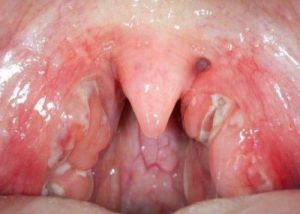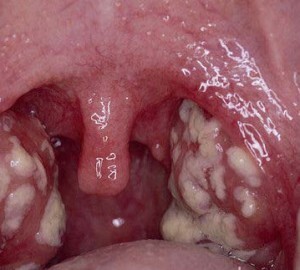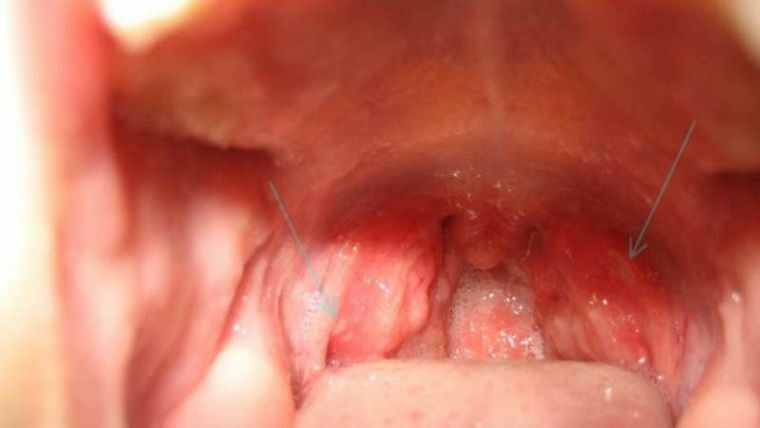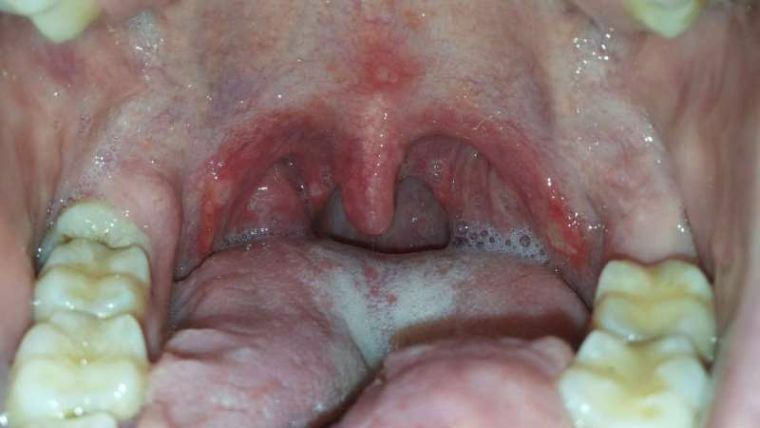 Stomatitis is an infectious disease that affects the oral cavity, there are several types of disorders, often white plaque and ulcers appear on the tonsils. Often, this form of the disease occurs in children, but adults can also be exposed to it.
Stomatitis is an infectious disease that affects the oral cavity, there are several types of disorders, often white plaque and ulcers appear on the tonsils. Often, this form of the disease occurs in children, but adults can also be exposed to it.
Inflammation and development of microorganisms on the tonsils is the most severe form of stomatitis. However, there is no acute symptomatology, therefore at an early stage the disease is difficult to detect.
Stomatitis on tonsils often develops as a complication after systemic viral infections. Another reason for this ailment is the failure to comply with the rules of personal hygiene. This form is rare and requires an integrated approach to treatment. Although with good immunity, the disease can go away by itself.
Contents
- Causes of the disease
- Variety of lesions
- Nature of the clinical picture and manifestations of
- Diagnostic methods
- How to distinguish stomatitis from sore throat?
- Difference from tonsillitis and other diseases of the same nature
- Approach to treatment
- Preventive measures
Causes of the disease
In general, stomatitis on the tonsils develops due to previously transferred inflammatory processes, that is, against the weakening of immunity. In addition, the cause may be a prolonged use of antibiotics, as well as carious teeth.
People with bad habits who abuse alcohol and smokers are at risk. In this case, prolonged and often negative effects on the mucosa appear. Often, the disease is observed in young children, who are at the age when all the objects are tapped "on the tooth."
Among the prerequisites for the development of painful microflora in the mouth are frequent hypothermia, which is the cause of decreased immunity. In addition, a sedentary lifestyle and malnutrition can also provoke the disease.
Variety of lesions of
A commonly accepted classification distinguishes several types of stomatitis, in which the throat and tonsils can be affected:
- medication occurs as a result of prolonged use of medications that are not perceived by the body;

- Primary herpetic or aphthous - the most common type of disease among children, can often be confused with herpes;
- Candidiasis - the cause of the disease is a yeast-like fungus;
- traumatic - pathology, which is a consequence of mucosal trauma, - injuries can be caused by prostheses, teeth, chemicals, as well as hot food or radioactive radiation;
- infectious form of the disease( second name vesicular) is transmitted by airborne droplets from pets or affected people;
- ulcerative-necrotic occurs when spindle-shaped bacteria enter the oral cavity, the prerequisites for this are a decrease in immunity, as well as a lack of vitamins;
- is not uncommon and is allergic to stomatitis, which usually develops due to the use of medications.
There are also many other types of stomatitis: angular, mercury, radiation, mycotic, gangrenous, stomatitis of smokers and others.
The nature of the clinical picture and the manifestation of
At home, it is simply impossible to detect stomatitis on the tonsils, as the outward appearance of the disease can easily be confused with angina, the difference is not large. Identify the true nature of inflammation and correctly diagnose only a specialist.
With the development of the disease in the tonsil area, the following symptoms may appear:
- pain syndrome and throat discomfort;
- there is an increase in lymph nodes;
- on the tonsils appear white or gray ulcers;
- also, inflammatory circles are formed;
- at later stages a whitish bloom is formed;
- the body temperature rises;
- from the outside of the throat is felt for swelling;
- , when palpation of the outer walls of the throat, a pain syndrome appears.
With early detection of the disease, treatment is much easier, faster and cheaper. At the advanced stages the number of microorganisms increases. They, in turn, can hit adjacent organs.

In the photo, the arrows indicate ulcers on the tonsils-a characteristic but not an obligatory symptom of stomatitis.
Diagnostic methods
Stomatitis is a disease that does not belong to a number of dangerous, but nevertheless it can cause many troubles. First of all, in order to detect pathology, it is necessary to examine the specialist.
In addition, a smear is taken from the surface of the tonsils, in order to conduct laboratory tests. Correct diagnosis contributes to successful treatment.
How to distinguish stomatitis from sore throat?
Despite the fact that bacterial tonsillitis and stomatitis on the tonsils are different diseases, they have similarities in common. In addition, there are cases when they occur in parallel. Differences of pathologies are as follows:
- Angina is detected and at an early stage in the form of a raid on the tonsils. In this case, only palatine tonsils are affected. It is caused by infectious agents, staphylococci and others.
- As for stomatitis, the disease affects the tonsils in the late stages. Before that, the pathology spreads on the cheeks and tongue. Often, such a complication is called a stomatitis.
There are general symptoms between angina and stomatitis:
- severe fever, fever;
- in both diseases increases lymph nodes;
- in addition, the patient in both cases feels weak.

Plaque with stomatitis is always present, with angina - not necessarily
Difference from tonsillitis and other diseases of the same nature
To distinguish stomatitis from other disorders that are of a similar nature, specialist help is needed. The ailments are quite serious, so timely treatment is needed to avoid serious consequences. Only a general analysis of blood and urine, as well as scraping on the microflora, can identify a specific disease.
Laboratory research contributes to the identification of provocative causes. With acute stomatitis and tonsillitis, the symptomatology is quite clear, therefore, diagnostics in the laboratory may not be necessary. If the mucous membrane is affected with stomatitis, pain syndrome appears, which spreads throughout the oral cavity. In case of tonsillitis or tonsillitis, discomfort is noted when swallowing.
In case of a parallel course of diseases, it is possible to distinguish them from the location of the affected areas. If tonsillitis develops, then on the tonsils appear ulcers and plaque white. In the case of stomatitis, in addition to the tonsils, the mucous lips and other areas of the oral cavity are also affected.
Approach to treatment
Treatment of stomatitis in each case individually. First of all, removal of ulcers, which are located on the tonsils, is required. It is also required to take medications that perform the most important tasks:
- relieve pain syndrome;
- eliminate the infectious process;
- heals;
- relieves unpleasant symptoms.
Assign: 
- pain relievers to relieve unpleasant symptoms;
- antiseptics allow to create an environment that is not suitable for the life of pathogenic flora;
- wound healing contributes to the elimination of wounds that are caused by the removal of formations on the tonsils;
- for the allergic nature of the disease prescribed antihistamines.
Preventive measures
In order to prevent the development of pathogenic bacteria in the oral cavity and prevent inflammation, it is necessary to adhere to preventive measures. First of all, they consist in maintaining the oral cavity and teeth in good condition.
Acute tooth edges should be removed, as they can cause sores. And in this case they can quickly spread throughout the oral cavity.
Regular cleaning of teeth is mandatory, dentists recommend doing this twice a day. In addition, it is recommended to use and rinse.
In rare cases, the cause of the disease can be food that irritates the mucous. In this case, you need to identify them and exclude them from the diet.
 Because the compromised immunity may cause the development of bacteria in the mouth, one should also follow this. It is necessary to pay attention to the state of health in general and eliminate sources of infection. Also, if possible, avoid stressful situations.
Because the compromised immunity may cause the development of bacteria in the mouth, one should also follow this. It is necessary to pay attention to the state of health in general and eliminate sources of infection. Also, if possible, avoid stressful situations.
From the environment of children, it is necessary to remove foods and objects that can not only infect the body, but also are potential sources of trauma to the mucosa.
An excellent method of prevention is hardening and diet. Keeping a healthy lifestyle allows you to avoid the development of other diseases. It is recommended to leave aside harmful habits that adversely affect health in general and can lead to more serious pathologies than stomatitis.
Do not forget that you need to carefully treat your health and undergo examination at the dentist and other specialized doctors at least once a year. In addition, the slightest change is a good reason for visiting a specialist. A timely reaction will avoid serious consequences, among which the spread of the inflammatory process to other body systems.
